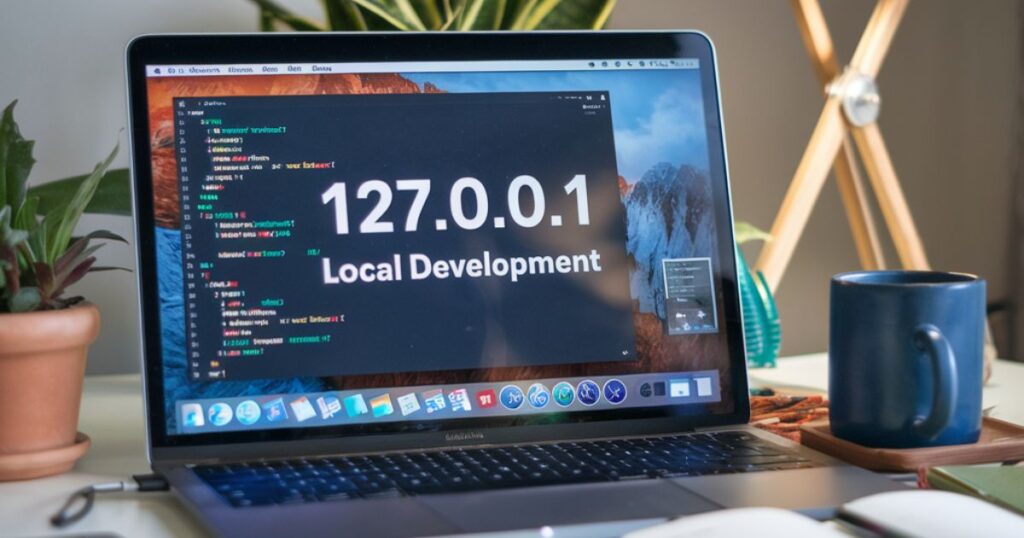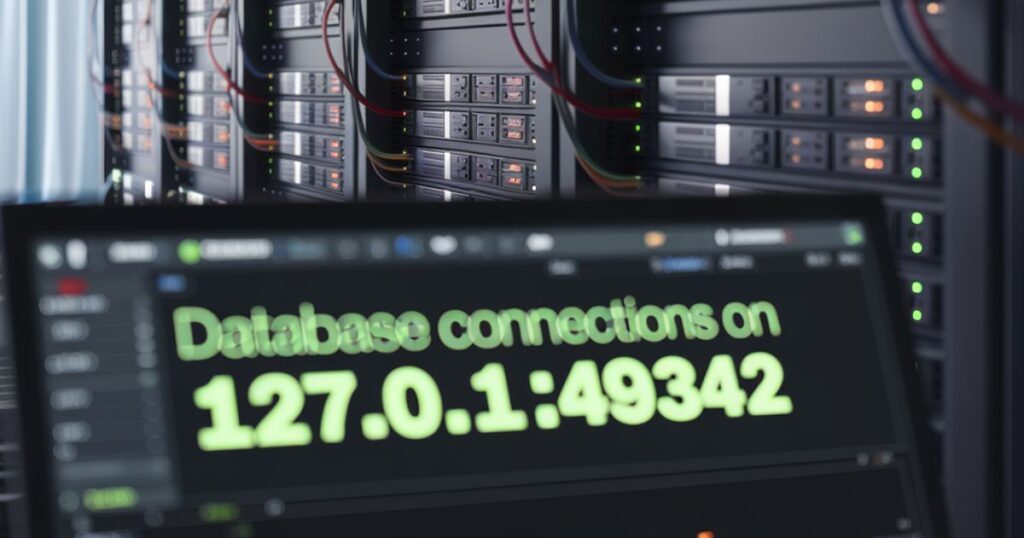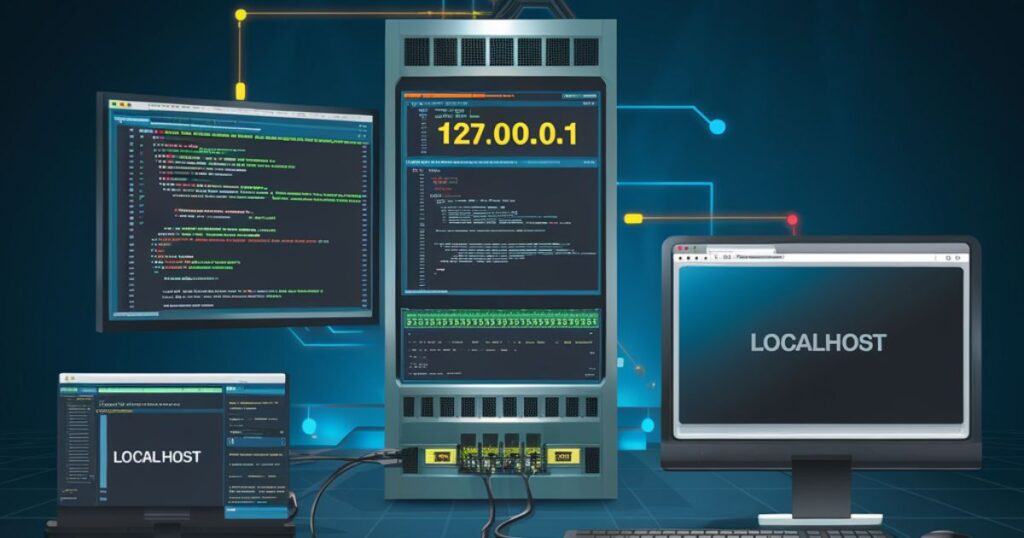In today’s fast-paced software development world, having a reliable and secure local development environment isn’t just nice to have – it’s essential. Let’s dive deep into understanding 127.0.0.1:49342, a powerful combination that’s revolutionizing how developers work in isolated, secure environments.
What Is 127.0.0.1:49342 Used For?
Picture this: You’re a software engineer working on the next big web application. You need a safe space to test your code without risking exposure to external threats. That’s where 127.0.0.1:49342 comes into play.
This dynamic duo consists of the localhost IP address (127.0.0.1) and a specific port number (49342) that creates a secure sandbox for development and testing.
Think of 127.0.0.1 as your computer’s home address, while port 49342 is like a specific door that only certain applications can use. This combination provides a controlled environment where developers can:
- Test APIs without external network exposure
- Run database connections safely
- Deploy web servers for local testing
- Simulate production environments
- Debug applications in isolation
127.0.0.1 Local Development

When you’re developing applications locally, you need a reliable way to test your code without deploying it to production servers. Local development using 127.0.0.1 (localhost) provides exactly that. This loopback address creates a closed circuit within your machine, ensuring all traffic stays local.
Here’s what makes localhost development so powerful:
- Zero Network Latency: Since everything runs on your machine, response times are lightning-fast
- Complete Control: You can modify configurations without affecting other developers
- Enhanced Security: No external network exposure means reduced security risks
- Real-time Testing: Instant feedback on code changes
Testing APIs with 127.0.0.1:49342
API testing is crucial in modern web development, and 127.0.0.1:49342 provides the perfect environment for it. When testing APIs locally, developers can:
// Example API endpoint configuration
const apiConfig = {
host: ‘127.0.0.1’,
port: 49342,
endpoint: ‘/api/v1/users’
};
This setup allows developers to:
- Test API endpoints without internet connectivity
- Simulate various response scenarios
- Debug complex API interactions
- Ensure data validation works correctly
Must Read: 5 Gimkit Codes That Always Work [2024]: Your Ultimate Student Gaming Guide
49342 Port for Secure Testing
Port 49342 isn’t just another random number – it’s a carefully chosen port that helps prevent conflicts with common services. Here’s why port selection matters:
| Port Range | Common Use | Risk Level |
| 0-1023 | System services | High |
| 1024-49151 | User applications | Medium |
| 49152-65535 | Dynamic ports | Low |
Database Connections on 127.0.0.1:49342
Database testing is a critical component of application development. When connecting to a database on localhost:49342, developers create a secure testing ground for data-driven applications. Here’s a practical example using a typical database configuration:
database_config = {
‘host’: ‘127.0.0.1’,
‘port’: 49342,
‘database’: ‘test_db’,
‘user’: ‘dev_user’,
‘password’: ‘secure_password’
}
In real-world scenarios, this setup enables developers to:
- Test database migrations safely
- Verify data integrity
- Optimize query performance
- Simulate high-load scenarios
Securing the 49342 Port
Security isn’t just an afterthought – it’s a fundamental aspect of local development. When working with port 49342, implementing robust security measures is crucial. Consider these essential security layers:
- Firewall Configuration
# Example firewall rule
iptables -A INPUT -p tcp –dport 49342 -s 127.0.0.1 -j ACCEPT
iptables -A INPUT -p tcp –dport 49342 -j DROP
- Access Control
- Implement strong authentication
- Use SSL/TLS for encrypted connections
- Monitor port activity regularly
How Does Port 49342 Work With 127.0.0.1?

Understanding the relationship between localhost and port 49342 is crucial for effective development. Think of it like this: if 127.0.0.1 is your house’s address, port 49342 is a specific window you’ve designated for passing messages. This combination creates a secure channel for local communication.
Key aspects of this interaction include:
- Process Isolation: Each service gets its own port
- Traffic Routing: All communication stays within your machine
- Resource Management: Efficient handling of system resources
Loopback IP and Port Mechanics
The loopback mechanism is fascinating in its simplicity and effectiveness. When data is sent to 127.0.0.1:49342, it never actually leaves your computer’s network stack. Instead, it follows this path:
- Application sends data to 127.0.0.1:49342
- Operating system recognizes the loopback address
- Data is redirected back through the network stack
- Receiving application gets the data instantly
This process is incredibly efficient because:
- No physical network interface is involved
- Zero network latency
- Complete isolation from external networks
- Perfect for testing network-dependent applications
Data Exchange on 49342
Data exchange through port 49342 follows specific protocols and patterns. Here’s how it typically works:
// Example WebSocket connection
const ws = new WebSocket(‘ws://127.0.0.1:49342’);
ws.onopen = () => {
console.log(‘Connected to local development server’);
ws.send(‘Hello, local server!’);
};
Application Isolation on 127.0.0.1
Application isolation is crucial for maintaining a clean development environment. When using localhost:49342, each application operates in its own space, preventing interference between different services.
Best practices for application isolation include:
- Running services in separate containers
- Implementing proper error handling
- Managing resource allocation effectively
- Monitoring system performance
Use in Web Development
Web development on localhost:49342 provides a powerful environment for creating and testing web applications. Here’s a typical setup for a local web server:
const express = require(‘express’);
const app = express();
app.listen(49342, ‘127.0.0.1’, () => {
console.log(‘Development server running at http://127.0.0.1:49342’);
});
Why Is 127.0.0.1 Called Localhost?

The term “localhost” has a fascinating history in network computing. Dating back to the early days of internet protocols, 127.0.0.1 was designated as a special IP address that always refers to “this computer.” It’s like having a secret passage in your house that always leads back to your living room.
Here’s what makes localhost special:
- It’s universally recognized across all operating systems
- The address is permanently reserved for loopback testing
- It provides consistent behavior for local development
- No external network access is required
History of Localhost
The concept of localhost emerged alongside the development of TCP/IP protocols in the 1980s. Initially designed for testing network software without requiring actual network hardware, it has evolved into an essential tool for modern software development.
Timeline of localhost evolution:
- 1981: Introduction of IP addressing
- 1983: Standardization of 127.0.0.1
- 1990s: Widespread adoption in web development
- Present: Critical component in containerized development
Local Development Benefits
Working with 127.0.0.1:49342 brings numerous advantages to the development process:
| Benefit | Description | Impact |
| Speed | Zero network latency | Faster development cycles |
| Security | Isolated environment | Reduced security risks |
| Reliability | Consistent behavior | Fewer environment-related bugs |
| Cost | No cloud resources needed | Lower development costs |
Security of Localhost
While localhost is inherently isolated, proper security measures are still crucial. Modern development practices require multiple layers of protection:
# Example security configuration
# Restrict port access
sudo ufw allow from 127.0.0.1 to any port 49342
# Enable SSL for local development
openssl req -x509 -newkey rsa:4096 -keyout key.pem -out cert.pem -days 365 -nodes
Localhost Across Operating Systems
One of localhost’s greatest strengths is its consistency across different operating systems. Whether you’re using Windows, macOS, or Linux, 127.0.0.1:49342 works the same way:
Windows PowerShell:
Test-NetConnection -ComputerName localhost -Port 49342
Linux/macOS Terminal:
nc -zv localhost 49342
Localhost vs. Other Private IPs
Understanding the difference between localhost and other private IPs is crucial for network configuration:
| IP Range | Use Case | Scope |
| 127.0.0.1 | Loopback testing | Single machine |
| 192.168.x.x | Local network | Home/office network |
| 10.x.x.x | Enterprise | Large networks |
| 172.16-31.x.x | Private network | Medium networks |
Securing 127.0.0.1:49342 for Development Testing

When it comes to securing your local development environment, you can’t be too careful. Even though 127.0.0.1:49342 is inherently isolated, implementing robust security measures is crucial. Let’s dive into a comprehensive security approach:
// Example secure server configuration
const https = require(‘https’);
const fs = require(‘fs’);
const options = {
key: fs.readFileSync(‘key.pem’),
cert: fs.readFileSync(‘cert.pem’),
secureProtocol: ‘TLSv1_2_method’,
ciphers: ‘HIGH:!aNULL:!MD5’
};
Firewall Rules for Localhost
Setting up proper firewall rules is your first line of defense. Here’s a robust approach to firewall configuration:
# Basic firewall rules for localhost protection
# Allow only local connections to port 49342
iptables -A INPUT -i lo -j ACCEPT
iptables -A INPUT ! -i lo -d 127.0.0.0/8 -j REJECT
iptables -A INPUT -p tcp –dport 49342 -s 127.0.0.1 -j ACCEPT
Key security considerations include:
- Restricting access to local processes only
- Implementing proper authentication
- Monitoring connection attempts
- Regular security updates
Regular Security Audits
Security isn’t a one-time setup – it requires ongoing attention. Here’s a practical security audit checklist:
- Weekly Checks
- Port scanning
- Process monitoring
- Log file analysis
- Resource usage review
- Monthly Reviews
- Security patch updates
- Configuration validation
- Access control verification
- Performance optimization
Avoiding Common Pitfalls
Learn from others’ mistakes to strengthen your local development environment:
| Common Issues | Prevention Measures |
| Port conflicts | Use dedicated port ranges |
| Memory leaks | Implement proper resource cleanup |
| Insecure configurations | Follow security best practices |
| Missing authentication | Require authentication even locally |
Best Practices for Local Development
Follow these industry-proven practices to maintain a robust development environment:
- Environment Configuration
# Example development environment configuration
environment:
host: 127.0.0.1
port: 49342
ssl: true
debug: false
logging:
level: info
path: ./logs
- Code Organization
- Use version control
- Implement proper error handling
- Follow coding standards
- Document configurations
Port Forwarding Considerations
When port forwarding becomes necessary, follow these guidelines:
# Secure port forwarding example
ssh -L 49342:127.0.0.1:49342 user@remote-host
Key considerations:
- Only forward ports when necessary
- Use encrypted connections
- Monitor forwarded connections
- Implement timeout mechanisms
Must Read: What is Gimkit Join? The Ultimate Guide to Revolutionary Classroom Gaming [2024]
FAQ’s
Is 127.0.0.1:49342 Safe for Development Testing?
Yes, when properly configured. The loopback address ensures traffic stays local, while port 49342 provides a dedicated channel for your application. Always implement proper security measures even in local environments.
How Can I Secure the 49342 Port?
Implement these security measures:
- Use firewall rules
- Enable SSL/TLS
- Implement authentication
- Monitor access logs
- Regular security updates
Can I Use 127.0.0.1 for API Testing?
Absolutely! It’s ideal for API testing because it:
- Provides isolation
- Enables rapid testing
- Eliminates network variables
- Supports secure testing
How Do I Troubleshoot Connection Issues on 127.0.0.1:49342?
Follow this troubleshooting process:
- Check if the port is in use
- Verify firewall settings
- Ensure service is running
- Review error logs
What Are the Security Risks of 127.0.0.1:49342?
Main risks include:
- Malware accessing local services
- Insecure configurations
- Port conflicts
- Resource exhaustion
Conclusion
127.0.0.1:49342 remains a cornerstone of modern software development. By understanding its capabilities and implementing proper security measures, developers can create robust, secure local development environments. Remember to:
- Regularly update security configurations
- Monitor system resources
- Follow best practices
- Maintain proper documentation
- Perform regular security audits
The key to successful local development lies in balancing convenience with security. By following the guidelines and best practices outlined in this article, you’ll be well-equipped to create and maintain a secure, efficient development environment.
Explore the latest news and insights from Vibrant’s and beyond at Vibrantsvista.com

Indu Pushpa is the admin of Vibrantsvista.com, offering insights on general topics with a passion for providing valuable, diverse, and engaging content to a broad audience.
